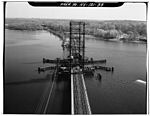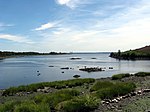Pelham Bay Park

Pelham Bay Park is a municipal park located in the northeast corner of the New York City borough of the Bronx. It is, at 2,772 acres (1,122 ha), the largest public park in New York City. The park is more than three times the size of Manhattan's Central Park. The park is operated by the New York City Department of Parks and Recreation (NYC Parks). Pelham Bay Park contains many geographical features, both natural and man-made. The park includes several peninsulas, including Rodman's Neck, Tallapoosa Point, and the former Hunter and Twin Islands. A lagoon runs through the center of Pelham Bay Park, and Eastchester Bay splits the southwestern corner from the rest of the park. There are also several recreational areas within the park. Orchard Beach runs along Pelham Bay on the park's eastern shore. Two golf courses and various nature trails are located within the park's central section. Other landmarks include the Bartow-Pell Mansion, a city landmark, as well as the Bronx Victory Column & Memorial Grove. Before its creation, the land comprising the current Pelham Bay Park was part of Anne Hutchinson's short-lived dissident colony. Part of New Netherland, it was destroyed in 1643 by a Siwanoy attack in reprisal for the unrelated massacres carried out under Willem Kieft's direction of the Dutch West India Company's New Amsterdam colony. In 1654 an Englishman named Thomas Pell purchased 50,000 acres (200 km²) from the Siwanoy, land which would become known as Pelham Manor after Charles II's 1666 charter. During the American Revolutionary War, the land was a buffer between British-held New York City and rebel-held Westchester, serving as the site of the Battle of Pell's Point, where Massachusetts militia hiding behind stone walls (still visible at one of the park's golf courses) stopped a British advance. The park was created in 1888, under the auspices of the Bronx Parks Department, largely inspired by the vision of John Mullaly, and passed to New York City when the part of the Bronx east of the Bronx River was annexed to the city in 1895. Orchard Beach, one of the city's most popular, was created through the efforts of Robert Moses in the 1930s.
Excerpt from the Wikipedia article Pelham Bay Park (License: CC BY-SA 3.0, Authors, Images).Pelham Bay Park
Orchard Beach Road, New York The Bronx
Geographical coordinates (GPS) Address Nearby Places Show on map
Geographical coordinates (GPS)
| Latitude | Longitude |
|---|---|
| N 40.865555555556 ° | E -73.808333333333 ° |
Address
Orchard Beach Road
Orchard Beach Road
10475 New York, The Bronx
New York, United States
Open on Google Maps








